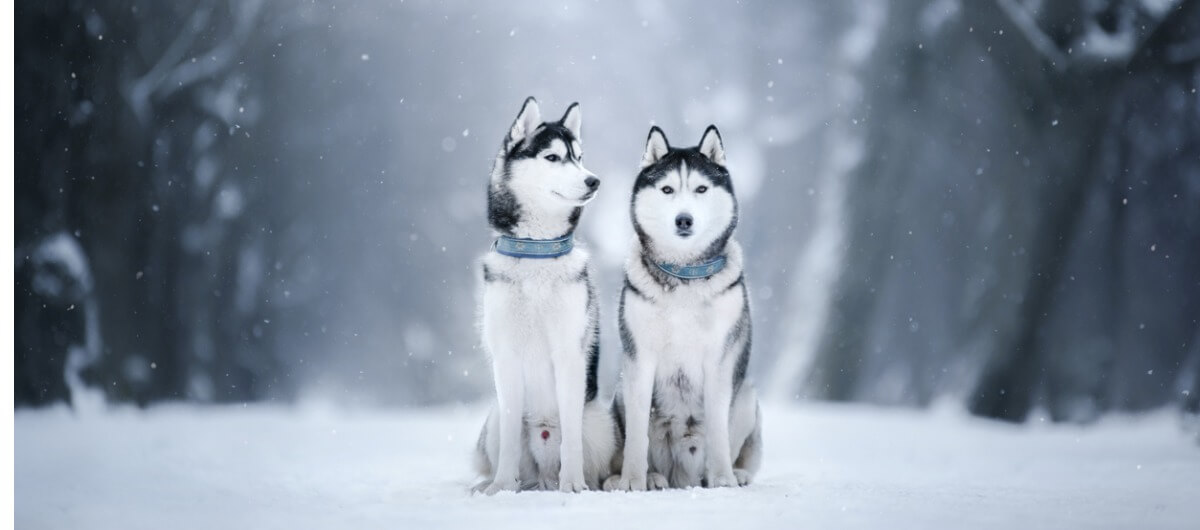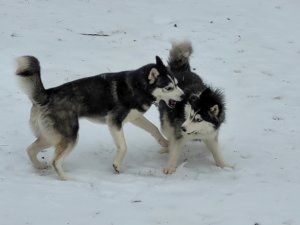

Power Structures
Dogs Really Are a Wonder
For many people sharing their lives with dogs, they're more than just a pet. And that's just the way evolution wants it.
This article was made possible because of the generous support of DAME members. We urgently need your help to keep publishing. Will you contribute just $5 a month to support our journalism?
For once, I’m going to write about something that makes me happy. It may come as a shock to most people who regularly read my rather grim forecasts for the United States and humanity that anything can make me happy, but yes, there’s something that does: namely our pack of rescued and surrendered huskies. I love making my coffee in the morning, coming down the stairs, and being greeted by a swirling melee of fur, fangs, howls, and wagging tails of housemates beside themselves with excitement even though they saw me only seven hours ago.
During the past two years, as I shifted to working from home 90 percent of the time, and our oldest moved out and went to college, these maniacs have been my constant companions during the day. With this breed of wolfish-looking dogs, you’re constantly reminded that you’re a half-step away from their wild ancestors, but they’re still very much dogs. One minute they’re gnawing on the back half of a squirrel that they caught in their lair (while I’m in a Zoom meeting, of course), and the next they want to play a game of “chase me.”
I wondered about this, and it made me go down the rabbit hole of research into why dogs have a relationship with humans unlike any other animal. They work for us. They’re companions and protectors. They’re friends, family, and surrogate children. Many people, including myself, believe that they’re companions and life lessons for our children as they both get older. We talk to them and anthropomorphize them to a degree that we do with no other animal. As I looked into why dogs are all these things to people, I was astounded at all the ways, large and small, that dogs have evolved to fit within our lives. Dogs are not a miracle in the divine sense, but in an evolutionary one.
Scientists believe that dogs split from an unknown extinct species of wolf about 40,000 years ago somewhere in Mongolia or Nepal, though interbreeding between the two likely continued for thousands of years. They were the first species of animal domesticated by hunter-gatherer humans. Perhaps they came from wolves who ventured close enough to the cook fires to accept scraps of meat. Perhaps they were taken as pups and raised as guards, protectors, and fellow hunters. They followed human migrations as well, splitting into distinct European and Asian groups about 20,000 years ago.
We do know that they were firmly embedded in human cultures as far back as 14,000 years ago, based on a grave found in Germany which contained a puppy, an adult dog, an adult man, and an adult woman being buried together. The DNA of these individuals were clearly dogs, and clearly modern humans. To put the time frames involved here in perspective, dogs had been a part of our families for at least (and probably much more than) 3500 years before we domesticated the first cattle, and at least 4000 years before humans planted their first crops. Rock-art from 8000 years ago in northwestern Saudi Arabia depicts a man with 13 dogs, two on leashes, hunting other wild animals.
Most of this information has been uncovered over the past 17 years, since dog DNA was first fully sequenced in 2005 (from a pure-bred boxer named Tasha, no less). In recent years, research using DNA has made it startlingly clear that dogs evolved in myriad ways to hack not only into human society, but into the most deeply hard-wired parts of our psyches.
The most noticeable personality differences between wolves and dogs are that wolves are still fundamentally wild animals: They remain skittish and timid around people, even if hand-raised by humans from birth. Even when hand-reared, wolf pups are far less likely to make eye contact and are less attracted to people, and grow even less so as adults. Dogs, however, remain gregarious and human- focused throughout their lives, and the reason seems to be a series of genes that dogs share with people.

In humans, errors in the WBSCR17 gene, along with a few others, can result in Williams-Beuren Syndrome (WBS). This genetic disease occurs in about 1-in-10,000 people and causes a host of medical issues. What is interesting is that people with WBS are prone to having mild to moderate intellectual disabilities, but these disabilities don’t affect language processing. At the same time, they are noted for being gregarious, loquacious, happy, socially uninhibited, empathetic, friendly, trusting, and making extended eye contact.
Where dogs and wolves come in is that when scientists looked at the genetic differences between dogs and wolves, they found that they had significant differences in the WBSCR17 sequence. Research into the differences between wolf pups and dog puppies found that puppies have the same language processing skills as wolves, but are far friendlier, more trusting, and make longer eye contact. Adult dogs have less cranial capacity than wolves and reduced reasoning skills. This has led researchers to conclude that dogs evolved to have a form of Williams-Beuren Syndrome. It potentially offered an advantage because the friendliest, most trusting individuals would be the ones most likely to get fed, and then taken care of by humans.
This strategy wouldn’t be nearly as successful if dogs hadn’t evolved to hack into human instincts to read faces and empathize with “cute” things (like babies). One of the small, but important physiological differences between dogs and wolves is that all dogs have evolved to have a specific set of muscles, the levator anguli oculi medialis, which is a muscle responsible for raising the inner eyebrow intensely. This allows dogs to elevate their inner eyebrow, making their eyes look larger. Wolves do not have this muscle.
Humans have evolved to have an extraordinary ability to read faces for the minutest expressions and ascribe emotional meaning to them. Additionally, infantile physical features, such as round faces and big eyes that are perceived as “cute” motivate caretaking behaviors in humans, with the evolutionary function of enhancing offspring survival. The muscle that dogs have to make their eyes seem larger and more expressive makes our human brains involuntarily see a dog’s face as having a sad, childlike expression, resulting in another involuntary response: a desire for caregiving.
Thus, dogs evolved to have a single muscle that hijacks both the human instinct to read faces, and to provide care to things which they perceive as childlike. Humans also derive oxytocin, a.k.a. the bonding hormone, from extended eye contact, which dogs also evolved to do via the WBSCR17 gene mutation. All of this works like a fucking charm. One study found that dogs in shelters who used this muscle more regularly were far more likely to be adopted.
There’s another muscle‚the retractor anguli oculi lateralis or RAOM, which pulls the eyelids toward the ears—that appears in most dogs, but not wolves, and not in some dogs (huskies) whose lineage is closer to wolves. (It’s probably also why our huskies come across as remorseless jerks, but I digress.)

One of the other amazing things about dog evolution is how quickly they adapted alongside humans. When they first joined up with humans, dogs and wolves were both carnivores. However, roughly 10,000 years ago, humans developed agriculture and starchy foods became more readily available. Humans had been evolving to eat more starchy diets for nearly 100,000 years, and so did dogs.
At roughly the same time as humans developed agriculture, dogs evolved to also be able to eat these starchy foods. In 2013 researchers identified 36 regions of the genome that set dogs apart from wolves. Nineteen of those regions have a role in brain development or function, likely related to sociability. They also found ten genes that help dogs to digest starches and break down fats, three of which make dogs better at breaking down starches into sugars. Thus, while dogs and humans had already been companions for perhaps 30,000 years already, we began evolving together.
Humans can communicate with dogs more instinctively than any other species. Puppies are literally born with the ability to interpret proximal pointing cues (i.e., you can point at something and a dog will look, or go, where you are pointing). This even works with feral adult dogs who have had limited interaction with humans. Elephants appear to be the only other animal with this ability. Human infants will also look where people point before the age of 12 months as well. Other animals that are more intelligent overall than dogs, such as chimpanzees and wolves, require training to look where a human points.
Dogs are also remarkably adept at reading human body language and faces, both of which are likely evolutionary adaptations. Studies have shown that body language is the primary way in which dogs gauge the emotional states of humans. Other studies have shown that dogs respond to human faces displaying Ekman’s six basic emotions ( anger, fear, happiness, sadness, surprise, disgust, and neutral) and appeared to process and respond to these visual cues. Different emotions caused different parts of their brains to “light up,” and non-neutral faces resulted in elevated heart rates. Dogs can also glean cues about human emotional states through smell.
More remarkable is how dogs react to these signals. Dogs show similar physiological responses to humans when they hear a baby crying. They also show physiological and behavioral signs of stress in the presence of a person crying. Dogs in this study also gave more attention and physical contact to the person pretending to cry. These studies are just part of the evidence of “emotional contagion” between humans and dogs, which is the most basic type of empathy and does not require higher psychological functions. This physiological intensity of the reactions of this emotional bond has been demonstrated to increase over time as the dogs become more attached to their owners. One recent study even suggests that dogs can experience emotional distress when a companion dies.
Dogs also process a surprising amount of information from human language, typically processing about 165 words, with many having vocabularies in excess of 250. Most can effectively count to four or five. This is roughly equivalent to a 2-year-old human child. They have emotional reactions to praise, and can tell the difference between real words and nonsense. They also recognize when their owners are speaking a different language. Dogs have effectively evolved to process language much the way humans do, in order to better integrate with the humans they live with.
Ironically, dogs may be better at reading people than people are at reading dogs. Researchers have found that people who don’t own dogs were better at reading the body language of dogs than people who did own one. The dog owners in the study mis-identified what emotion a dog was feeling while watching a dog interact with a child in a video almost two-thirds of the time, whereas non-owners were only wrong about a quarter of the time.
The biochemical bond between people and dogs is a symbiotic one. Over the past decade a series of studies have shown that both people and dogs produce oxytocin when interacting with each other in a calm, relaxed way. Some studies have shown that these interactions can reduce cortisol (a stress hormone) as well. The longer the relationship between owner and dog, the more pronounced the effects are. This is the same biofeedback loop you find between mother and child. “It’s an incredible finding that suggests that dogs have hijacked the human bonding system,” says Brian Hare, an expert on canine cognition at Duke University in Durham, North Carolina.
It should be no wonder that many people regard dogs as their “fur babies.” They exist as permanent children who derive comfort and pleasure from interacting with us. For those same reasons, our emotional relationships with dogs tend to be emotionally uncomplicated. Dogs do not care if you’re a murderer or a fascist. But they are a companion species whose entire evolutionary strategy revolves around manipulating instincts into loving and protecting them.
It’s unsurprising then that most people have more empathy for dogs than they do for people: We see them as uncomplicated, guileless, and innocent in the same way that we do children. Similarly, children in homes with dogs exhibit more prosocial behaviors, perhaps because they have more opportunities to practice empathy and the fundamentals of emotional contagion. For adults, when their dogs die they often experience grief as intensely as if it were a close family member or child.
Bill Murray once said, “I’m suspicious of people who don’t like dogs, but I trust a dog when it doesn’t like a person.” I’m inclined to agree. Dogs evolved to exploit our deepest instincts for empathy, caring, and protection more efficiently and effectively than other human beings do. When a dog fails to elicit any of these responses in a person, it leads me to believe that the person is incapable of those emotional reactions in general.
Such is the case of the human dumpster fire named Donald Trump, who had the social IQ of a salted slug. Many people who worked with him are convinced he has narcissistic personality disorder. This manifested itself in innumerable situations where he demonstrated himself to be utterly incapable of the most basic levels of empathy or kindness. Even Hitler loved his dogs, but Trump despises them. His ex-wife Ivana confirmed in her autobiography that not only does he hate them, but that her poodle Chappy was afraid of Trump and “barked territorially” at him in an effort to protect her. “How can you not love a dog that acts like he’s won the lottery for life just because he sees you walk through the door?” she wondered.
Maybe we should all listen to Chappy next time. Whenever I hear that someone hates dogs, for reasons other than fear based on personal or ancestral trauma, I have to wonder why the deeply embedded emotional response mechanisms that they should have are completely broken. They evolved to be optimized for human companionship, and it is a testament to the power of life and evolution that they found so many ways, great and small, to be our companions.
Before you go, we hope you’ll consider supporting DAME’s journalism.
Today, just tiny number of corporations and billionaire owners are in control the news we watch and read. That influence shapes our culture and our understanding of the world. But at DAME, we serve as a counterbalance by doing things differently. We’re reader funded, which means our only agenda is to serve our readers. No both sides, no false equivalencies, no billionaire interests. Just our mission to publish the information and reporting that help you navigate the most complex issues we face.
But to keep publishing, stay independent and paywall free for all, we urgently need more support. During our Spring Membership drive, we hope you’ll join the community helping to build a more equitable media landscape with a monthly membership of just $5.00 per month or one-time gift in any amount.



















































































